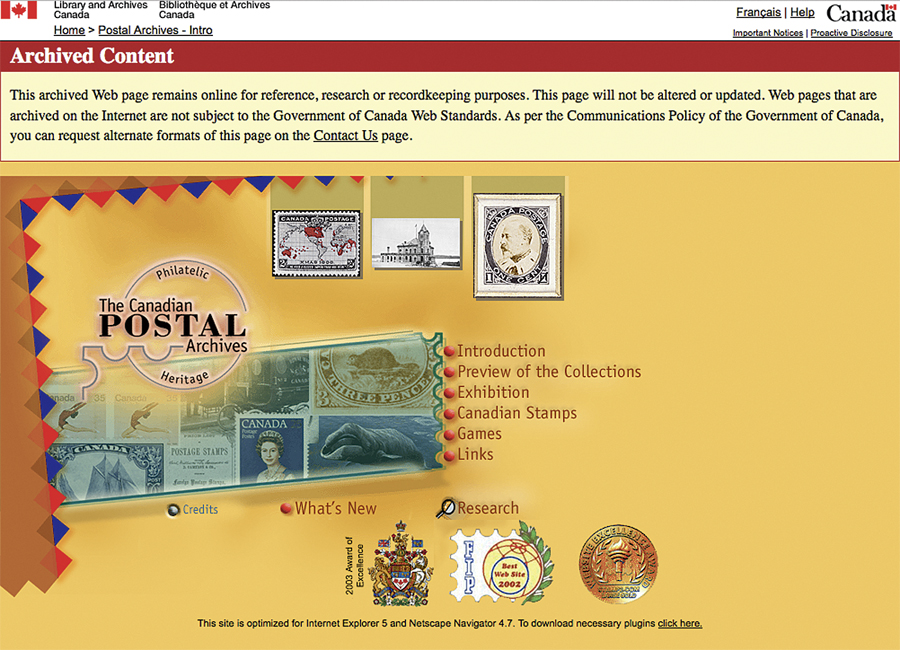For years, one of the best-kept secrets of Canadian postal history was the Canadian Postal Museum.
Tucked away in a back corner of the top floor of the Museum of Civilization in Gatineau, across the river from Ottawa, the museum contained a collection of one of every Canadian stamp and galleries covering the history of postal service in Canada. It didn’t get a lot of attention. I received a guided tour of the museum in 2010. When we got to the postal section, my official guide said he didn’t know much about the stamps and left me to my own resources. Compared with the main exhibits, there were few tourists taking in the stamps.
In 2012, the museum was closed.
At that time, the Museum of Civilization announced it would move the stamp collection into a new gallery, incorporate philately into other exhibits, and build on virtual exhibits on the museum’s website.
The collection reopened in 2014 with more than 3,000 stamp exhibits in a gallery on the first level.
While the new location gives the public better access to the stamps, few collectors have taken the time to look at the various online exhibits located at historymuseum.ca/event/the-canadian-stamp-collection.
There are eight virtual exhibits.
First up is “A Chronology of Canadian Postal History.”
Covering the period of New France to modern day, the exhibit is basically bullet points of significant postal events. While the focus is on Canada, world events significant to postal history are included, giving the national scene some international context. The links inside the chronology are a nice touch. Clicking on one of them opens up a pop-up window with additional information on the person or event.
The second exhibit is on the Royal Stamp Collection.
A number of years ago more than 400 items from Queen Elizabeth II’s personal collection were on display in the museum.
Collectors unable to attend at that time, or those who want to remember, can view the entire exhibit and supporting information from the comforts of their home.
The collection is broken into sections covering the birth of the modern British post, Canadian postal autonomy, and Canadian treasures, including a stamp designed by the future King George V. Unfortunately, a section allowing collectors to upload videos of their own collections is no longer functioning.
The remarkable story of Chris Bennedsen, a Scandinavian immigrant to Canada in the early 1950s, is told through more than 700 letters.
Bennedsen, who corresponded extensively, collected his mail along with associated photographs and memorabilia.
His correspondence describes the immigrant experience in Canada, and the dramatic changes of the postwar era. It also reminds us of the importance of letter writing at a time when even overseas telephone calls were rare.
An article on the Canadian Labour Stamp, written by David Frank, is the basis of another exhibit.
Frank is not an impartial observer, but a passionate labour advocate. He presents a theory that the working-class experience is not adequately represented and calls for its inclusion as a Canadian symbol.
A 1997 exhibit on the early days of airmail, from 1919 to 1939, presents early Canadian airmail history in relation to cultural events in the country and around the world.
Rather than update the appearance of the exhibit, curators have retained its distinctive pre-millennium look and feel.
The fascinating period of Canadian postal reform in the early 1800s is the topic of another exhibit.
While official postal service in Canada dates from much earlier times, much mail was still carried by travellers and ship captains as a favour to the sender.
Service expanded slowly and by 1840 there were more than 400 postmasters in Canada handling a total of almost two million pieces of mail. Unsorted mail was shipped in bags, often without any security.
The inherent inefficiencies and costs of such a system led to postal autonomy for Canada in 1949.
With centralized control of mail firmly in the hands of government, local stamps were issued, and services were improved and standardized. The struggle for postal control was seen as part of a challenge to imperial authority and a call for an independent Canada.
There is also an exhibit on mail carried by dogsled. The Yukon gold rush of the 1890s led to a demand for government services, including mail. Traditional methods of carrying mail were not practical, particularly in the winter, and dogsleds were put to use.
The exhibit presents the context of the time, and details on the dogs, the sleds and the mail.
Philatelists know that early Canadians used the mail for more than just keeping in touch.
In the days before online shopping, both urban and rural customers ordered everything from clothes to furniture by browsing through the pages of mail-order catalogues.
The exhibit includes sample catalogue pages, details on the ordering and delivery process, corporate histories, and a timeline.
Again, while the emphasis is on Canada, information is presented in the context of actions and retailers in Canada, Europe, and the United States.
Names such as Eaton’s, Woodward’s, Carsley’s, and the Hudson’s Bay Company figure alongside great mail houses such as Roebuck and Montgomery Ward.
There are sections for collectors, for teachers, and for students.
The museum also maintains the Canadian postal archive, an online collection of Canadian stamps, with supporting information on designers and production.

